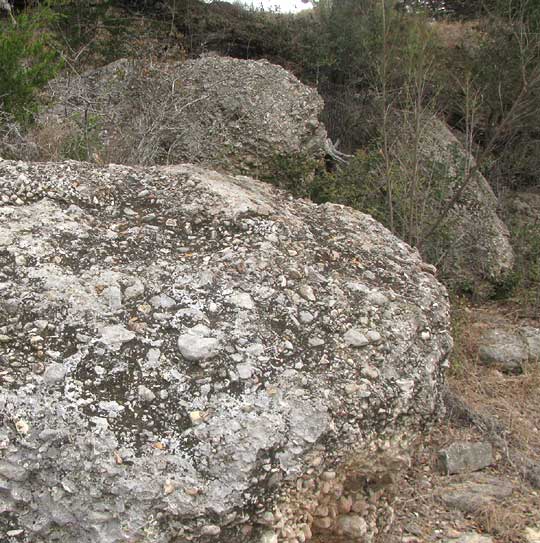Excerpts from Jim Conrad's
Naturalist Newsletter
from the March 2, 2014 Newsletter issued from the Frio Canyon Nature Education Center in the valley of the Dry Frio River in northern Uvalde County, southwestern Texas, on the southern border of the Edwards Plateau; elevation ~1750m (~5750 ft); N29.62°, W99.86°; USA
CLAUZADEA LICHEN
We've seen that lichens come in endless variations, sometimes flashy and sometimes obscure, and that they can reproduce in surprising ways. A species encountered this week presented itself as little more than a white patch inside which a multitude of tiny pits occurred, the pits extending into the limestone boulder on which the lichen resided.
This lichen occupied an unusual substrate. Along a dry arroyo, or normally dry stream, it grew on boulders consisting of conglomerate rock which itself was composed of limestone pebbles and rocks cemented together with calcium-rich marl that hardened into rock-hard cement 110 million years ago. The original loose pebbles, rocks and mucky marl had accumulated at the bottom of the shallow sea that occupied this area early during the Cretaceous Period. Below, you can see boulders on which this lichen species occurred:

An apple-size splotch of the white lichen with its peppering of pits is seen below:

A close-up of the pits, which are no larger than pin-pricks, is seen below:

The white surface in that picture is the lichen's body, or thallus, consisting of no more than a flat plane of fungal hyphae in which photosynthesizing algal cells are enmeshed. The pits are remains of reproductive structures called "ascomata." The lichen produced an acid that dissolved the limestone below each ascoma, forming the pits. I read that eventually the ascomata in these pits issue their spores, then fall out, leaving just the pits. Crustose lichens growing on stone normally dissolve some of the stone, but it's unusual for a species to go at it in this manner. Ascomata sunk in pits in rocks are said to be "endolithic."
Having so few anatomical features to work with, I could identify this species only by searching for labeled pictures on the Internet. Of the hundreds of crustose lichen pictures looked at, the best match was with CLAUZADEA METZLERI, which the LichenPortal.Org website indicates has been collected in the Texas Hill Country near San Antonio, though it appears to be best documented in Eurasia. The only English name I can find for it is Clauzadea Lichen.
Not much information is available on this lichen's presence in North America, so I'm happy to document it here.